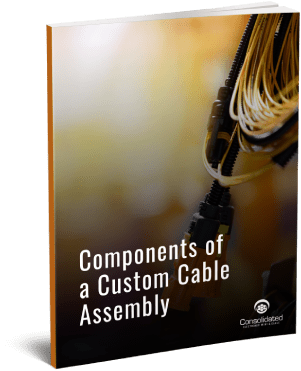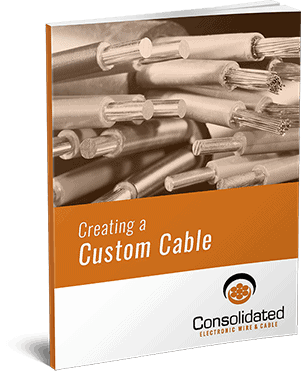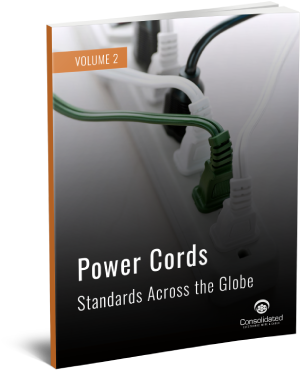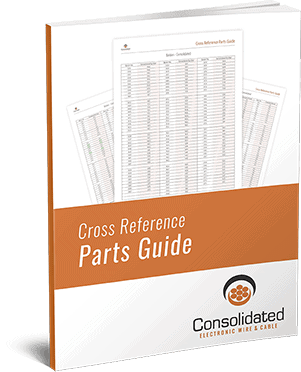Consolidated Electronic Wire & Cable is a leading provider of various cable solutions. With a century of experience, we are proud to offer various types of high-performance coax cables that deliver optimal efficiency and reliability across a range of applications. As part of our product offerings, we can provide low loss cable types in different configurations to suit your needs.
What is a Low Loss Cable?
Low loss coaxial cables, or coax cables, are used in various transmission applications such as Wi-Fi, cable television, digital audio, radio frequency networks, cellular networks, Wireless Local Area Networks (WLAN), and several other systems that need low signal attenuation. Most coax cables fall into one of two categories, RG (Radio Guide) and low loss, but unlike most coaxial cables, low loss cables use tinned copper and aluminum tape for their shielding rather than bare copper, tinned copper, or aluminum tape alone. This results in better shielding effectiveness.
Low loss is newer and better than RG cable, originally designed to replace certain RG cables. Low loss cables are rated for a 6 GHz maximum operating frequency and can hold up in environments with temperatures up to 85° C. These cables are typically marked “CEWC-#,” with the number indicating the approximate cable diameter. For example, CEWC-400 has a 0.405″ OD (outer diameter).
Types of Low Loss Cable
There are several types of low loss cables, including:
- The CEWC-100A-PVC coaxial cable is designed to replace RG-316 and RG-174. It’s very thin and has more than double the shielding of RG-174, which significantly cuts down on signal interference.
- This CEWC-195/CEWC-195UF coaxial cable was made to replace RG58 and RG142. It has superior shielding and 20-33% less attenuation.
- The CEWC-200/CEWC-200UF has the same 0.195″ OD as the CEWC-195 cable but a slightly larger center conductor allowing for less signal loss than the CEWC-195.
- This CEWC-240/CEWC-240UF was designed to replace the RG8X cable. CEWC-240 cable has a 35%-64% less signal loss than RG8X.
- The CEWC-400/CEWC-400UF was made to replace RG8, the CEWC-400 cable is the most common low loss cable. It has another variation known as CEWC-400-75, one of the few low loss cables designed for 75 ohm applications.
- The CEWC-600 is unlike other low loss cables for CEWC-600 wasn’t made to act as a replacement for RG coax cables. It has a thick and powerful build, with the capability of transmitting signals up to 500 feet. This makes it ideal for application in powerful satellite frequency transmissions.
Low Loss Applications
Low loss coaxial cable can be used virtually anywhere high-performance coaxial cables are used. For example, they are ideal for:
- Drop-in Replacement for some RG Cables
- Short Antenna Feeder Runs
- Jumper Assemblies in Wireless Communications Systems
- Applications that require an easily routed, low loss RF cable, such as GPS, WLAN, GPS, Mobile Antennas, and More
Low Loss Coaxial Cable Specifications
At Consolidated Electronic Wire & Cable, we offer low loss cables in various configurations and specifications to meet diverse needs.
| Feature / Characteristic | CEWC-100 | CEWC-195 | CEWC-195UF | CEWC-200UF | CEWC-240 | CEWC-240UF | CEWC-400 | CEWC-400UF |
|---|---|---|---|---|---|---|---|---|
| Application | Indoor/Outdoor | Outdoor | Outdoor | Outdoor | Indoor/Outdoor Riser | Outdoor | General | Outdoor |
| Impedance - The electrical circuit's resistance to alternating currents, measured in ohms. | 50ohm | 50ohm | 50ohm | 50ohm | 50ohm | 50ohm | 50ohm | 50ohm |
| Dielectric Type- The insulating or non-conducting material between outer and inner conductors in a coaxial cable. | Solid PE | Solid PE | Foam PE | Foam PE | Foam PE | Foam PE | Foam PE | Foam PE |
| Velocity of Propagation - The length of time it takes for an electrical signal to travel down a cable versus travelling in air, measured as a percentage. | 66% | 75% | 76% | 83% | 84% | 85% | 85% | 85% |
| Shielding - The primary function of shielding within a cable is to confine the electric field to the insulation. AL= Aluminum | TC = Tin Copper | AL Foil/TC Braid | AL Foil/TC Braid | AL Foil/TC Braid | AL Foil/TC Braid | AL Foil/TC Braid | AL Foil/TC Braid | AL Foil/TC Braid | AL Foil/TC Braid |
| Jacket Diameter - An isulating layer of plastic or rubber covering a cable or bundle of wires | .110 in | .195 in | .195 in | .195 in | .240 in | .240 in | .405 in | .405 in |
| Jacket Material - The jacket is a vital component of a power cord. It protects the power cord's inner conductors from external factors, such as harsh temperatures or environmental conditions. | PVC | PE | TPE | TPE | FR-PVC | PE | PVC | TPE |
| Center Conductor Type- The wire in the middle of the coaxial cable, the diameter of which is based on the American Wire Gauge(AWG)'s standardized gauge system. BC= Bare Copper | BCCS = Bare Copper Covered Steel | BCCAI = Bare Copper Covered Aluminum. | Solid BCCS | Solid BC | Stranded BC | Stranded BC | Solid BC | Stranded BC | Solid BCCAI | Stranded BC |
Low Loss Cable Types from Consolidated Electronic Wire & Cable
Low loss coaxial cables ensure very low transmission loss, allowing fragile signals to be transmitted safely and effectively. At Consolidated Electronic Wire & Cable, we’re committed to quality assurance and will work with you to provide the ideal low loss cables to meet your application requirements. To learn more about our offerings and discuss how we can help improve your signal transmission system, reach out to the team or request a quote today.

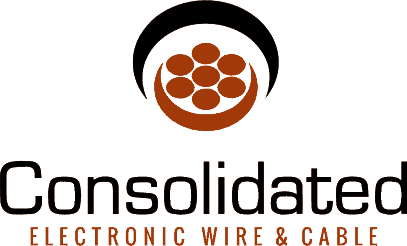


 () Quote Cart
() Quote Cart